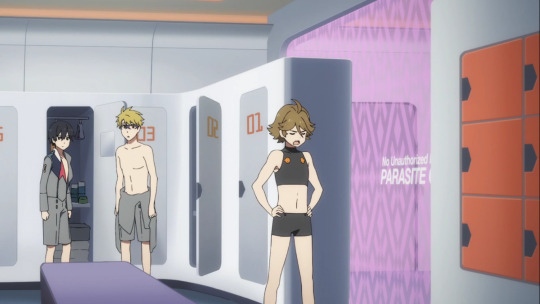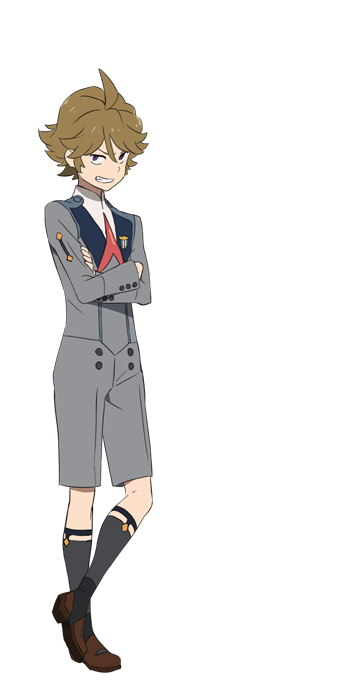by Brett Glasscock

It took watching anime for me to realize I have learned how to read in trans. Sure, I have known what transness is since my early days on Tumblr, and I have been working with critical trans thought for the past couple years of my undergraduate career, but I did not really know that I knew how to read in trans. I have known how to read in cis my entire life, which is to say that it is my native language more or less. Not that I was ever taught to explicitly recognize something as cis; cisness tends to remain unnamed in its own code of signs. Rather, I was taught—by family; school; society, as fickle a word as that is—to assimilate everything into a cis understanding of gender. Moments of nonnormativity could be accepted to a certain point. Some men just have high pitched voices, for example. I became an expert at reading people and bodies as men and women, boys and girls. Cisness did not give me the grammar to understand anything between or beyond. Anything in excess of cisness was a blank spot, a non-sign. But somewhere along the way, I learned how to read in trans. I developed, or maybe more accurately was keyed into, a language for the betweens and beyonds and aboves of transness. I found signs in the blank spots and the non-signs. And anime opened my eyes to this change.
Darling in the FRANXX is not a great show. Especially if we are talking about gender. The basic premise is as follows. Humanity is somewhere between the apocalypse and post-apocalypse. Adults are, for some reason or another, immortal, but because of their immortality, they have very low energy levels and quickly become fatigued. Oh and they have also lost their reproductive abilities. And so they genetically engineered a generation of children—lovingly dubbed “parasites.” These parasites, with all their vitality, are tasked with defending the adults from klaxosaurs, a race of dinosaurs-cum-aliens attacking human civilizations to steal their magma energy. To defend the adults and magma energy, the parasites pilot giant robots, or FRANXX, in boy-girl pairs (or, in the show’s terminology, stamen-pistil). If it sounds reminiscent of 2013’s blockbuster hit, Pacific Rim, it’s because it is. Darling in the FRANXX straddles a similar line of mecha versus kaiju deathmatches and budding romances between copilots.
Darling in the FRANXX seems like an impossible show to read in trans. It eschews transness at every level. But I found a way. By accident. In the first episode of the show, all the stamens, or boys, are shown getting ready to test-pilot their FRANXX. They are crowded around in a locker room of sorts, joking around and hyping each other up for the test run. All are shirtless except for one. Zorome is shown, for less than a second, in some kind of halter top. My immediate interpretation was that he was wearing a binder. As this was the first episode and I was still oblivious to just how cis the show is, I thought it was a nice touch that they would reveal a character as trans so nonchalantly in the first episode. At this point in the series I did not know much about Zorome, but everyone used he/him pronouns with him and he was with the other stamens, so I just figured he was a trans boy. The matter seemed pretty cut and dried.

Over the next few episodes, as I learned more about Zorome, his transness solidified in my mind. He is quickly painted as the most immature of the boys, and he has a bit of an uncomfortable relationship with the girls. Zorome is loud and boisterous. He makes not-so-funny jokes and tries to pull a few too many pranks. He is also quick to anger and grows resentful of the other boys when they are better than him at something. While he never shows any romantic interest in any of the girls, the boys see him as borderline perverted. He grabs girls’ breasts and talks openly about genitalia. He also endlessly dreams of growing up and becoming an adult, leaving behind childhood and FRANXX piloting. I didn’t see these traits as flaws for him to overcome, though; they made perfect sense to me in the context of his transness. Of course Zorome has a difficult relationship with the other boys. He is coming into his masculinity, testing the waters and trying to figure out how his transness fits into their rigidly gendered social structure. And he is not perverted; before transitioning, back when everyone treated him as a girl, he was used to how comfortable everyone was with each other’s bodies. I understood his desire to grow up already as a desire to “skip” the most difficult parts of his transition, a trope I have heard often in trans coming-of-age stories.
Except, Zorome is not trans. A few episodes later, the parasites take a break from fighting the klaxosaurs and go to the beach. All the boys are shirtless again. Zorome is not wearing a binder, not even the same halter top that looked like a binder. Confused, I paused the episode and googled every permutation of “Darling in the FRANXX” and “trans” I could think of. Nothing. Reddit and the fan Wikipedia confirmed that there are no trans characters in Darling in the FRANXX. The closest the show comes to transness is a special class of parasites introduced later who can take on either the pistil or stamen role when piloting FRANXX. As it turns out, Zorome is cis. He was just wearing a halter top in the locker room scene in the first episode, or maybe it was his piloting suit and I saw wrong. I had to recast everything I knew about Zorome. His was not a trans coming-of-age story. He really was the anime trope of comic relief pseudo-pervert who matures but keeps his boyish charm as the story progresses. In a totally cis way.
All the traces of transness I found in Zorome were a product of misreadings and misrecognition with a fair bit of projection and wishful thinking thrown in there. I learned how to read transness, but I read it a bit too well. In the same way that I sometimes mistake the German word for poison, “Gift,” with its English cognate, I misread a cis boy’s halter top and immaturity as their trans cognates. Somewhere in the process of my education in critical queer and trans studies, I learned not just how to read trans in the world around me, but how to read trans into the world around me. I find it in places it is not, in romance mecha anime and everywhere else. Which is all to say that there is a thin and thinning line between trans analysis and trans projection, and we should not see that as disappointing or threatening the legitimacy of trans media studies. Instead, my trans (mis)reading of Darling in the FRANXX gestures toward the power of trans recoding, of the way queer and trans people have retooled and transformed and expanded the limited language of cisness into something for us, into a space of community and shared experiences in the blank spots and non-signs originally offered us.
How can we account this process, this uncomfortable middle ground between reading and misreading? I think I would call it misreading. The name misreading, as inconvenient as it may be to type, captures what I believe to be a necessary dimension of my experience with Zorome and Darling in the FRANXX. On reflection, I see it less as a misstep and more as a kind of stubborn, small-scale resistance to cisness’s systems of meaning. And that is the use of the practice of misreading. It names the evolution of our encounter with a piece of media. Our trans, queer readings oppose authorial intent and to that end, are misreadings, but by recasting them as misreadings, we recode the word with the strikethrough, open the possibility of our oppositional readings as true readings. This kind of wishful thinking is important because it allows for the possibility of recoding the language of cisness into one of transness. Through continuing to misread media, to find transness where it is not, we not only challenge grammars of cisness but further build our grammars of transness, eventually writing it where it is not.
Because of its premise, the show is predicated on cisness, to the degree that transness is never mentioned or implied or hinted at. Transness would call the story into crisis, and the showrunners ostensibly did not want to think through how the FRANXX would respond to trans or gender-nonconforming pilots. The closest the show comes is when Ikuno—a canon lesbian—wants to try a pistil-pistil, or girl-girl, connection to pilot a FRANXX. So she and another girl go into the cockpit and get set up. The FRANXX does not respond. It really requires a (cis) boy and a girl. Throughout the rest of the series, no one ever makes another attempt at breaking or bending these gendered rules. Everyone, even Ikuno and her eventual girlfriend, appear pretty comfortable with this rigid gender system.

Brett Glasscock is a senior studying Rhetoric and Writing with a minor in Queer Studies. His academic interests center critical study of HIV/AIDS cultural production and its relationship to queer/disabled thought. His not-so academic interests include: postmodern literature, queer literature, gardening, poetry, his cats, and statement earrings.
